Enterprise Speech-to-Text: Cost vs Benefits
Explore the cost-benefit analysis of enterprise speech-to-text solutions, comparing major platforms to enhance efficiency and accuracy in business operations.
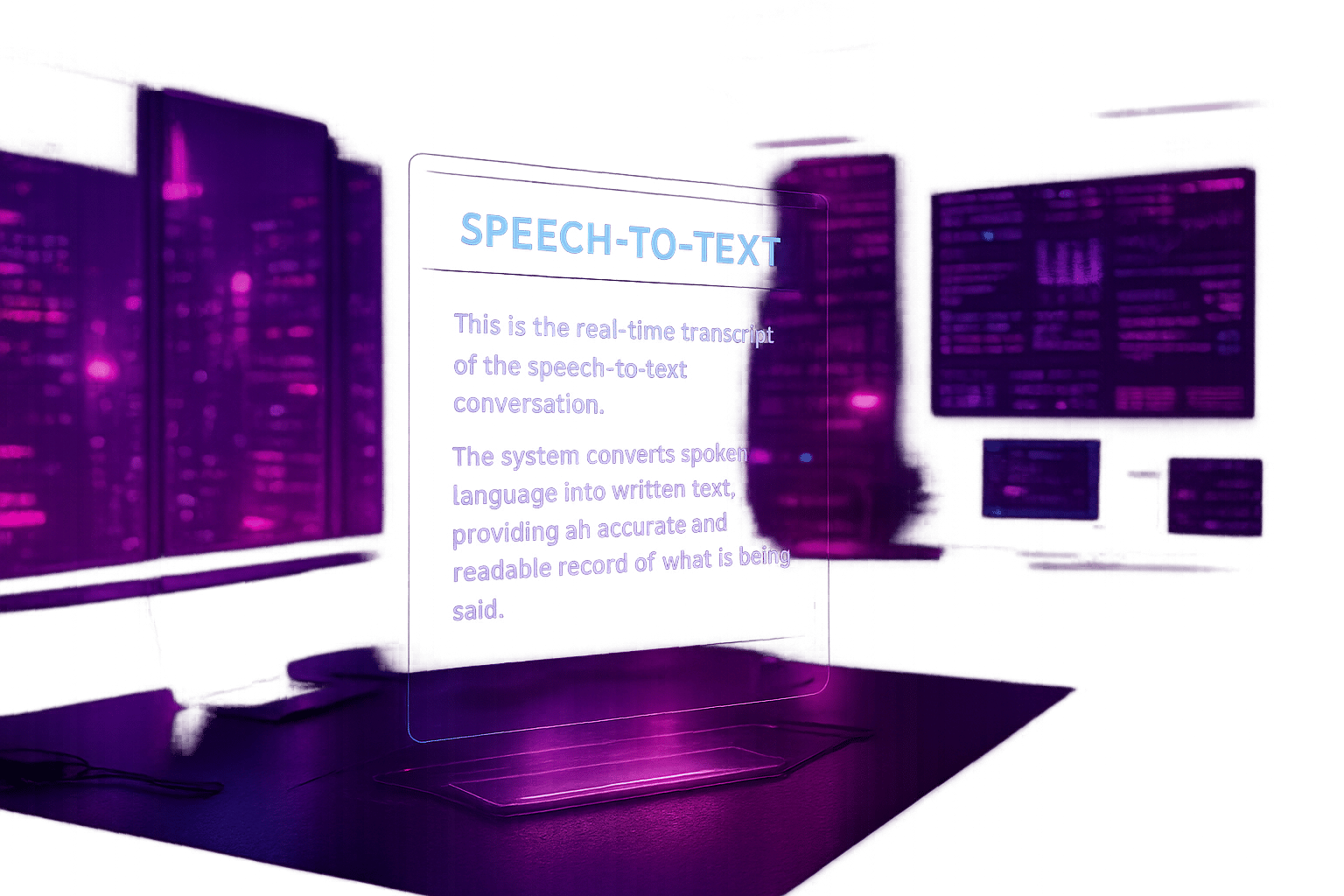
Speech-to-text technology has become a key tool for businesses, offering faster workflows, cost savings, and improved customer experiences. By 2033, the U.S. voice recognition market is expected to grow from $4.1 billion in 2024 to $11.5 billion. Companies are adopting these solutions to cut costs, save time, and scale operations.
Here’s a quick breakdown of four major platforms:
- Microsoft Azure Speech Services: Offers custom models and flexible pricing, starting at $1.00 per hour for transcription. Ideal for businesses needing tailored solutions.
- Google Speech-to-Text: Known for accuracy and tiered pricing, starting at $0.016 per minute. Discounts apply for high usage.
- Amazon Transcribe: Multilingual support and competitive rates, starting at $0.024 per minute with volume discounts.
- Deepgram: Focused on speed and affordability, with rates as low as $0.0043 per minute for pre-recorded audio.
Each platform has unique features, pricing, and deployment options. Choosing the right one depends on your needs - whether it’s real-time transcription, cost efficiency, or advanced customization. Below, we’ll explore their specifics to help you decide.
Speech to Text: 7 Tools You MUST Know
1. Microsoft Azure Speech Services
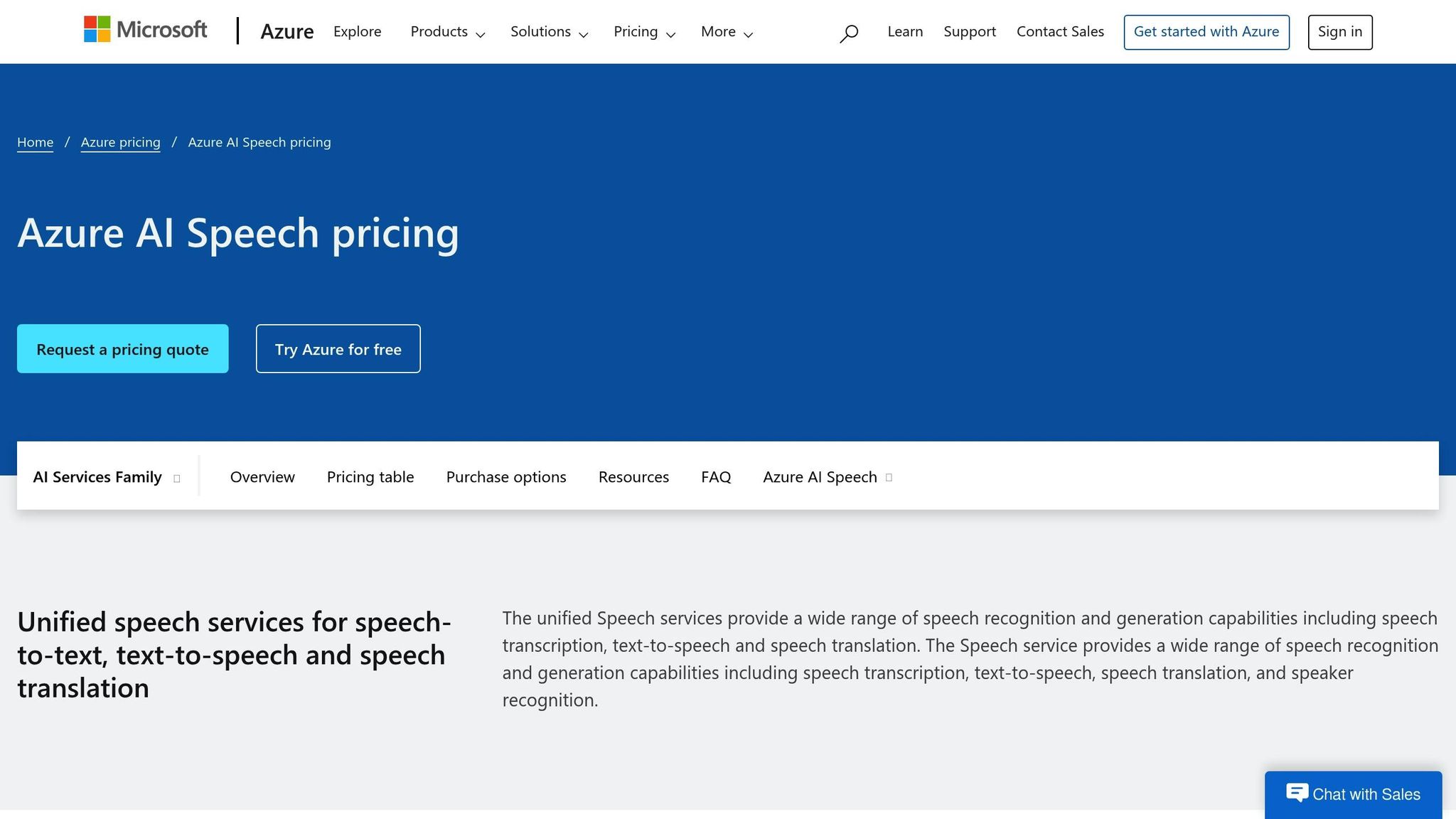
Microsoft Azure Speech Services combines speech-to-text, text-to-speech, and translation into a single, powerful platform. Its capabilities have been tested and proven in real-world scenarios. For instance, Peloton uses Azure to generate live subtitles and train on specialized terminology.
Pricing Structure
Azure provides a free tier that includes 5 audio hours per month for speech-to-text and 0.5 million characters for text-to-speech. Beyond this, its pricing is flexible, following a pay-as-you-go model:
- Standard transcription: $1.00 per hour
- Batch transcription: $0.18 per hour
- Custom real-time transcription: $1.20 per hour
- Custom batch transcription: $0.225 per hour
- Enhanced real-time add-ons (e.g., speaker diarization and continuous language identification): $0.30 per hour (bundled with batch processing)
For high-volume users, commitment tiers offer substantial cost reductions. For example, committing to 50,000 hours annually drops the standard transcription rate to $0.50 per hour and custom transcription to $0.60 per hour. For organizations requiring complete data isolation, disconnected container pricing begins at $74,100 per year for 120,000 hours, which equates to approximately $0.62 per hour.
These pricing models are designed to support a wide range of enterprise needs with flexibility and scalability.
Key Features
Azure Speech Services cater to both real-time and batch transcription needs. Real-time transcription is ideal for live scenarios like meetings, call centers, or voice assistants. Batch transcription, on the other hand, handles large volumes of prerecorded audio efficiently. Notably, Microsoft achieved human parity in conversational speech recognition back in 2016, reaching a 5.1% word error rate by 2017.
Custom Speech models allow businesses to fine-tune recognition for industry-specific terms or challenging audio conditions. Other advanced features include:
- Speaker diarization: Identifying who is speaking and when
- Pronunciation assessment: A valuable tool for language learning applications
- Continuous language identification: Supporting environments where multiple languages are spoken
Deployment Options
Azure offers a variety of deployment models to meet diverse security and compliance needs:
- Cloud-based deployment: A fully managed solution with global availability and automatic updates.
- Connected containers: On-premises deployment that retains cloud connectivity for updates and billing - ideal for organizations with strict data residency requirements.
- Disconnected containers: Fully air-gapped deployments for highly sensitive environments, available at a premium cost.
Scalability
Azure is designed to scale effortlessly, handling usage spikes through its global infrastructure to ensure low-latency processing. Custom model hosting is priced at $0.0538 per model per hour, and users can easily transition from pay-as-you-go pricing to commitment tiers as their needs grow.
"With Microsoft Azure Cognitive Services for Speech, customers can build voice-enabled apps confidently and quickly in more than 140 languages. We make it easy for customers to transcribe speech to text (STT) with high accuracy, produce natural-sounding text-to-speech (TTS) voices, and translate spoken audio".
2. Google Speech-to-Text
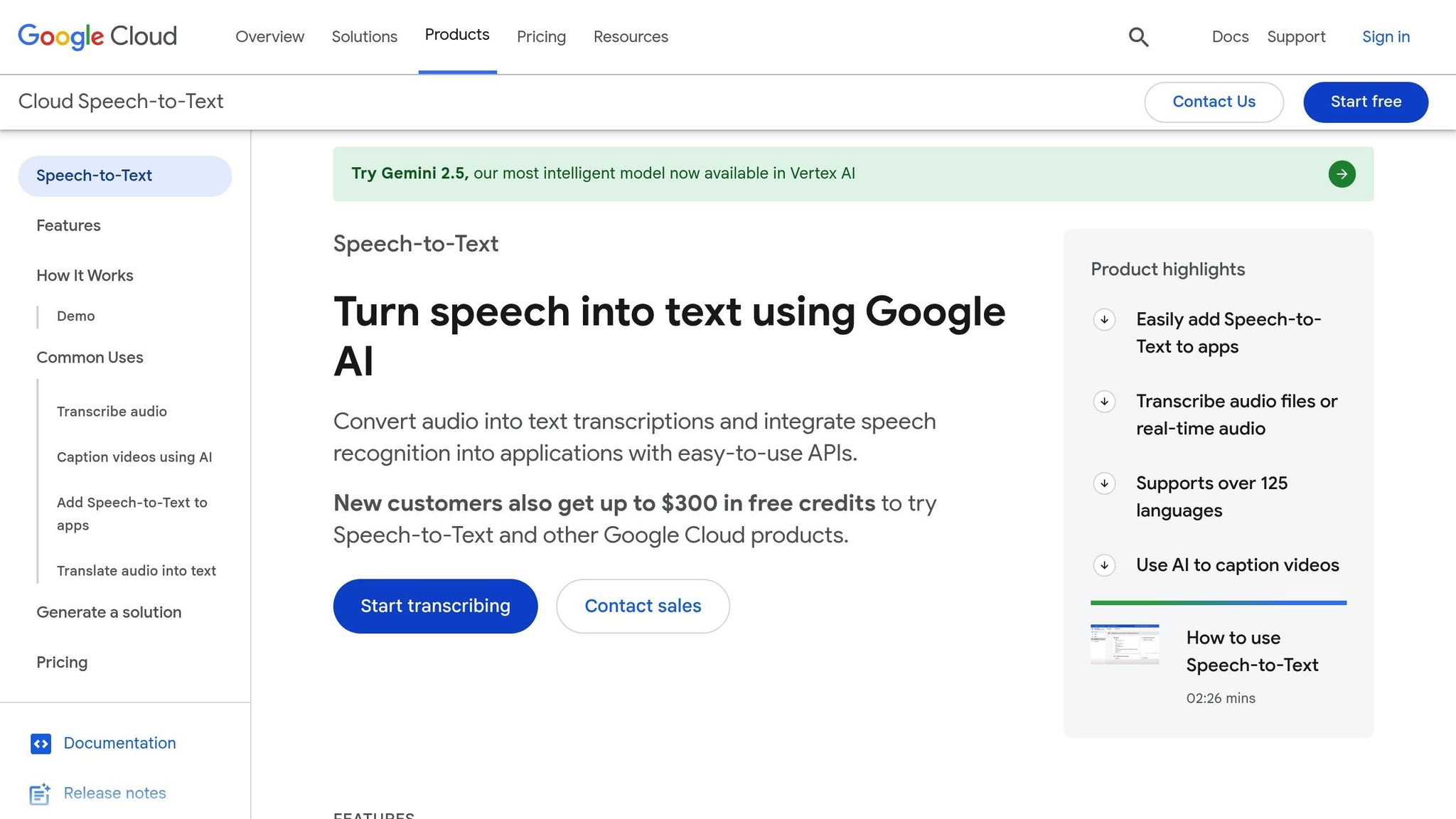
Building on the discussion of Microsoft Azure's pricing structure, Google Speech-to-Text also focuses on volume-based discounts and scalability. Powered by Chirp - Google Cloud's advanced foundation model for speech - this platform has been trained on massive datasets of audio and text. This training enables it to deliver precise transcriptions, even when dealing with various accents, languages, or challenging audio conditions.
Pricing Structure
Google Speech-to-Text uses a tiered pricing model, which becomes more affordable as usage increases. The Speech-to-Text V2 API has a base rate of $0.016 per minute, with discounts applied at higher usage levels:
- 0 to 500,000 minutes: $0.016 per minute
- 500,000 to 1,000,000 minutes: $0.010 per minute
- 1,000,000 to 2,000,000 minutes: $0.008 per minute
- Over 2,000,000 minutes: $0.004 per minute
At its highest tier, costs can drop by up to 75% compared to the base rate. For large-scale workloads, additional volume discounts may also be negotiated. New users benefit from $300 in free credits and 60 minutes of free transcription each month, making it easier to test the service. This pricing model is designed to accommodate growing enterprise needs.
Key Features
Google Speech-to-Text supports over 125 languages and variants, making it an excellent choice for businesses with diverse customer bases. It offers three primary recognition methods - synchronous for instant results, asynchronous for batch processing, and streaming for real-time use. Its standout features include:
- Model Adaptation: Improves accuracy for frequently used words or phrases.
- Speech Adaptation: Customizes recognition for industry-specific terms.
- Multichannel Recognition: Differentiates between audio channels in recordings.
- Speaker Diarization: Identifies who is speaking in a conversation.
- Automatic Punctuation: Produces polished, readable transcripts.
- Noise Robustness: Maintains accuracy even with background noise.
In a 2020 benchmarking study, Google's system achieved a 20.63% error rate when transcribing English-as-a-second-language dialogues, outperforming IBM Watson's 38.1% and Wit's 36%.
Deployment Options
Google Speech-to-Text offers both cloud-based and on-premises deployment options, catering to a range of business needs. The cloud-based option provides easy implementation, automatic scaling, and frequent updates. For organizations with strict data requirements, data residency controls allow transcription to occur within specific geographic regions.
The platform also includes enterprise-level security features such as audit logging, customer-managed encryption keys, and compliance with regulatory standards. For businesses requiring complete control over their infrastructure, on-premises deployment is available. This flexibility makes it suitable for a variety of enterprise setups.
Scalability
Designed for enterprise-level operations, Google Speech-to-Text efficiently manages workloads of all sizes with automatic scaling. Its three processing methods - synchronous, asynchronous, and streaming - allow businesses to tailor the service to their specific needs. The tiered, pay-as-you-go pricing model further enhances cost efficiency. When planning for scalability, companies should also factor in additional costs like customization, integration, and related Google Cloud services such as storage.
3. Amazon Transcribe
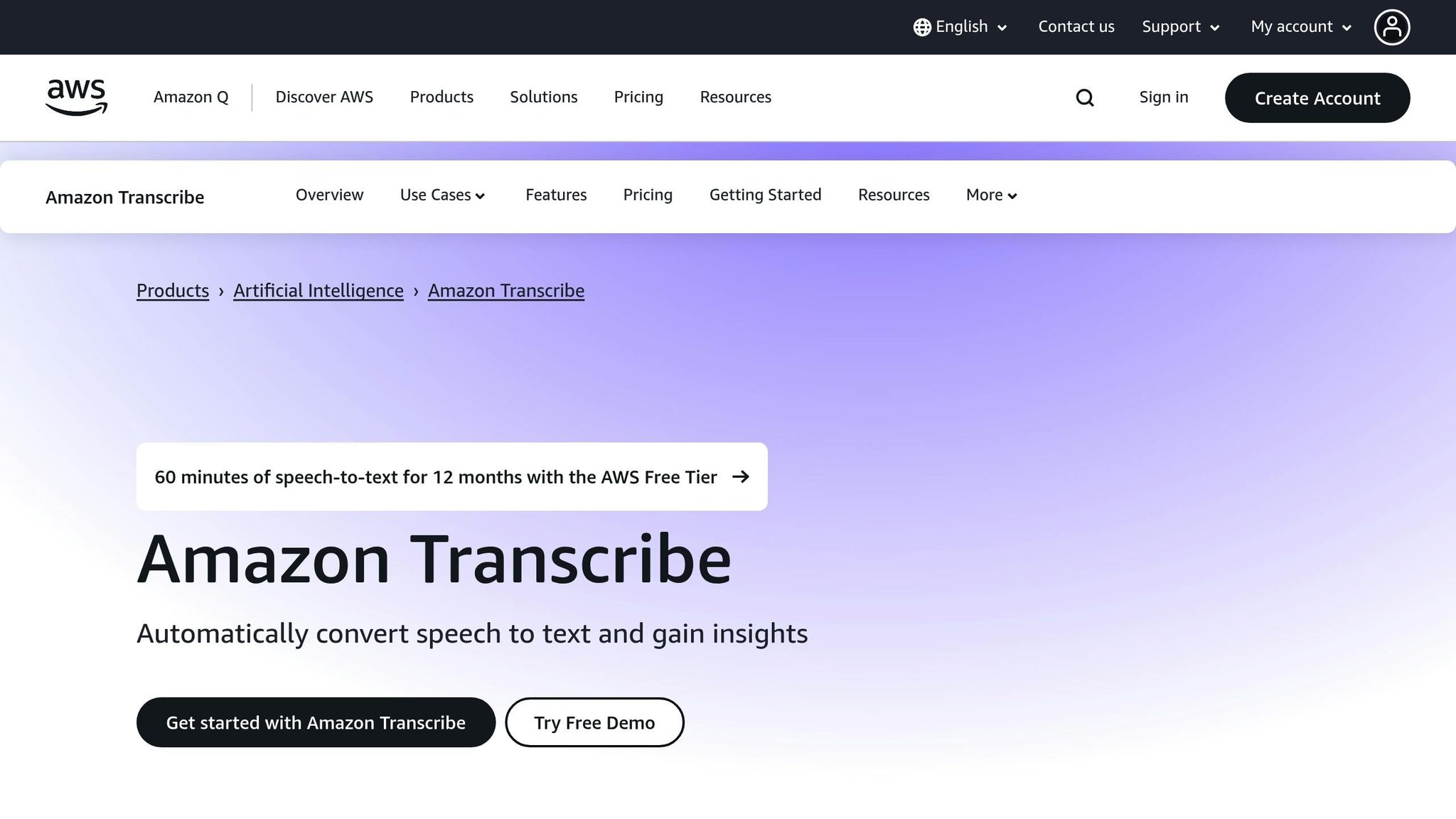
Amazon Transcribe is a fully managed speech recognition service designed to deliver precise transcriptions, even in challenging audio environments. Its accuracy can reach up to 90%, depending on the quality of the audio and the complexity of the content.
Pricing Structure
Amazon Transcribe operates on a pay-as-you-go model, charging in one-second increments with a minimum of 15 seconds per request. New users can take advantage of 60 minutes of free transcription each month for the first year.
The pricing tiers are designed to accommodate varying transcription volumes:
- First 250,000 minutes: $0.024 per minute
- Next 750,000 minutes: $0.015 per minute
- Next 4,000,000 minutes: $0.0102 per minute
- Over 5,000,000 minutes: $0.0078 per minute
Additional features, such as PII Redaction, Custom Language Models (CLM), and Toxicity Detection, are billed separately. For example, PII Redaction starts at $0.0024 per minute for smaller volumes and drops to $0.00078 per minute for large-scale users. Similarly, CLM costs begin at $0.006 per minute and scale down to $0.00198 per minute at higher usage levels. Toxicity Detection ranges from $0.0036 to $0.0012 per minute, depending on volume.
For specialized use cases, like contact center analytics, Amazon Transcribe Call Analytics pricing starts at $0.03 per minute for both post-call and real-time analytics, with generative call summarization available from $0.0024 per minute. For healthcare applications, Amazon Transcribe Medical offers flat-rate pricing at $0.075 per minute.
These pricing tiers make it easier for businesses to manage costs while scaling their transcription needs.
Key Features
Amazon Transcribe supports over 100 languages and provides both real-time streaming and batch transcription capabilities. Its features include:
- Automatic punctuation
- Custom vocabulary support
- Automatic language identification
- Speaker diarization
- Word-level confidence scores
- Vocabulary filters
The platform also offers domain-specific models tailored for phone calls and multimedia content. To ensure privacy and user safety, it includes tools like vocabulary filtering and PII redaction. Seamless integration with other AWS services, such as S3 and Lambda, allows for automated workflows.
Real-world applications highlight Amazon Transcribe's effectiveness. NASCAR, for instance, uses it to automate captioning across their website, which spans 195 countries and 29 languages. Patrick Carroll, Senior Director of Development at NASCAR, shared:
"With Amazon Transcribe, we were able to build an automated system that is almost entirely hands off for our team while giving us the ability to control how to customize the speech recognition for our needs. Since implementing Amazon Transcribe, we automatically add captions to 99% of our VOD content and spend 97% less than what we had originally estimated."
Similarly, Northwestern Mutual saw a dramatic improvement in transcription accuracy - around 95% compared to the 70% offered by their previous solution - leading to greater adoption among their financial representatives.
These features and real-world successes demonstrate Amazon Transcribe's reliability for enterprise use.
Deployment Options
Amazon Transcribe offers flexible deployment options to meet diverse security and integration needs. It supports private network communication through VPC endpoints, AWS PrivateLink, or Direct Connect, ensuring sensitive data doesn't traverse the public internet.
The service enforces strict security measures, including encryption (both in transit and at rest), IAM roles, and tag-based access controls for granular permissions management. It also integrates seamlessly with AWS monitoring tools, providing comprehensive oversight.
In October 2024, Amazon showcased a practical application of its real-time transcription capabilities with a sample static website. Using Node.js and the WebSocket API, the project demonstrated how to implement real-time audio streaming. The complete setup instructions and code are available on GitHub.
Scalability
Amazon Transcribe's infrastructure is built for dynamic scalability, adapting to fluctuating demand with ease. Whether you need to process vast archives or provide real-time captions, the service can handle both batch and streaming transcription efficiently.
The tiered pricing model ensures costs align with usage, making it a cost-effective choice for enterprises with varying workloads. For instance, Formula 1 used Amazon Transcribe to address their unique challenges, including high-speed commentary and complex technical terminology. James Bradshaw, Head of Digital Technology at F1, explained:
"Amazon Transcribe is a powerful tool; it performs transcription with incredibly high accuracy, which grows every day. F1's use-case was extremely challenging; the combination of incredibly high speed and dynamic commentary from multiple contributors, a global vocabulary and niche technical terminology. Working in close collaboration with AWS, we built and trained a scalable subtitling solution with accuracy and performance that matches human Closed Captioners."
This adaptability makes Amazon Transcribe a reliable option for enterprises looking to scale their transcription needs without compromising on performance or cost efficiency.
4. Deepgram
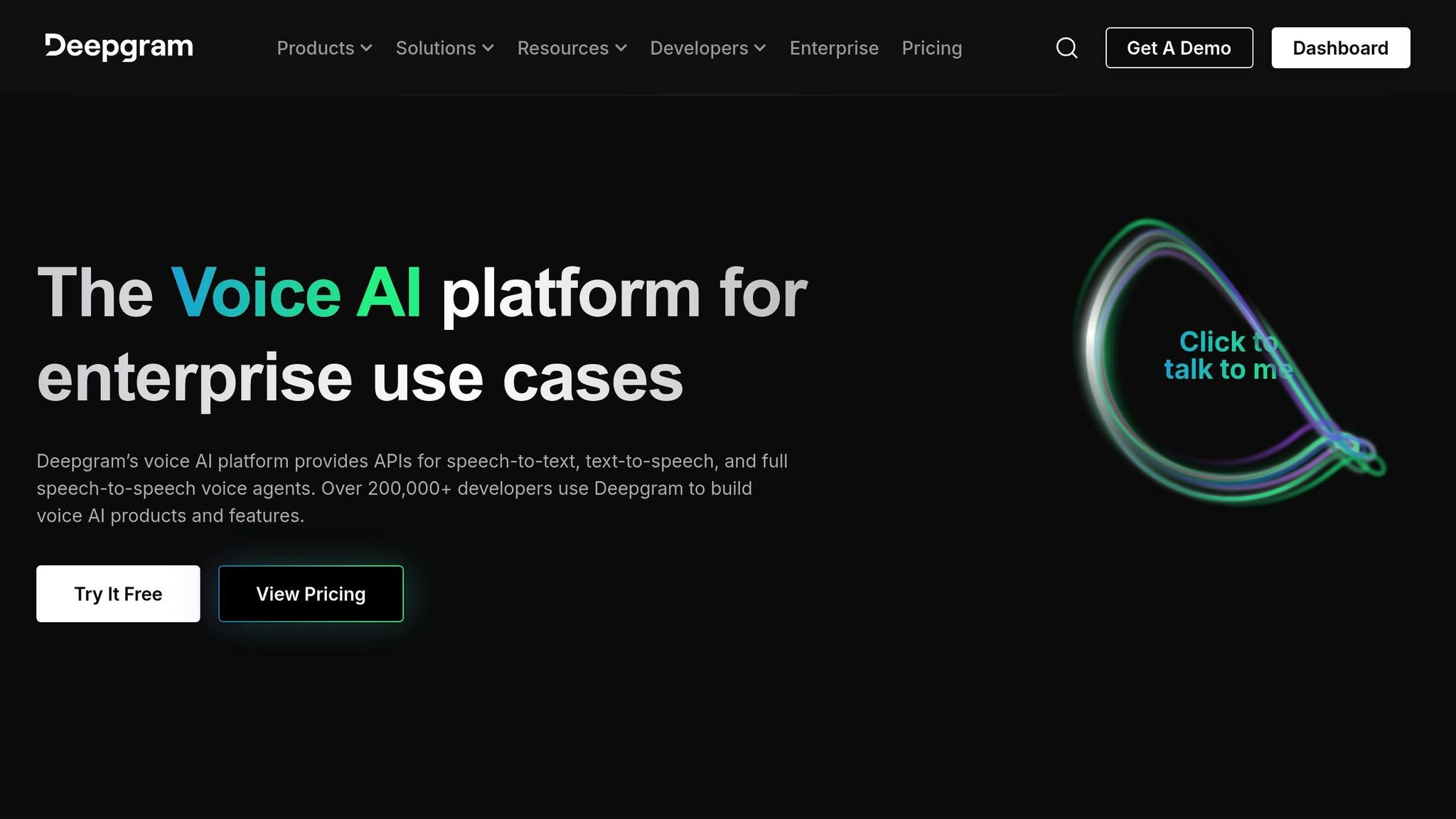
Deepgram stands out as a developer-focused speech-to-text platform, leveraging a fully deep learning approach powered by GPU infrastructure. This allows it to deliver transcription that's faster, more precise, and highly scalable compared to traditional ASR (Automatic Speech Recognition) solutions.
Pricing Structure
Deepgram offers three pricing tiers, catering to businesses of various sizes and needs. Its infrastructure is touted as being 3–5 times more cost-efficient than many alternatives.
- Pay As You Go: This entry-level plan starts with $200 in free credits - no credit card required. Once the credits are used, businesses only pay for what they use, with no minimums or expiration dates. For English transcription, the Nova-3 model costs $0.0043 per minute for pre-recorded audio and $0.0077 per minute for streaming. Multilingual transcription rates are $0.0052 per minute for pre-recorded audio and $0.0092 per minute for streaming.
- Growth: Designed for mid-sized businesses, this plan requires an annual commitment starting at $4,000. It offers up to 20% savings through pre-paid credits. Rates drop to $0.0036 per minute for English pre-recorded audio and $0.0065 per minute for streaming, while multilingual rates are $0.0043 and $0.0078 per minute, respectively.
- Enterprise: Tailored for large-scale operations, this plan starts at $15,000 annually and includes custom pricing based on volume. Deepgram also provides specialized Voice Agent API pricing, with standard configurations costing $4.50 per hour and custom language models priced at $3.90 per hour.
Key Features
Deepgram delivers up to 90% accuracy for typical business audio straight out of the box and can transcribe hour-long recordings in just 30 seconds. Supporting over 36 languages and dialects, it’s well-suited for global enterprises.
The platform includes features like speaker diarization, keyword boosting, and automatic formatting. Advanced tools include noise reduction for challenging environments, sensitive data redaction, and the ability to handle both real-time streaming and batch processing.
Customer feedback highlights the platform's strengths. Brendan Chan, CTO of Talkatoo, shared how Nova-3 significantly improved veterinary term recognition:
"We saw a massive jump in accuracy with Nova-3. Previous models recognized only 10% of critical veterinary terms, but with Nova-3 and keyterm prompting, we're seeing a 625% improvement."
David Zhao, CTO of Livekit, also praised the Nova-3 model:
"Deepgram has another winner with the Nova 3 model. I've observed significant improvements in transcription accuracy, particularly with proper nouns."
In February 2025, Deepgram introduced a speech-to-speech architecture that bypasses text conversion entirely. This innovation preserves emotional nuances while reducing latency, building on the company’s experience processing over 50,000 years of audio and transcribing over 1 trillion words.
Deployment Options
Deepgram offers flexible deployment options to meet diverse security and compliance needs. Businesses can train custom models using their own data, enabling better recognition of industry-specific terms, accents, and jargon.
The platform includes APIs and SDKs for seamless integration into existing workflows. It also provides specialized speech models for different use cases, ensuring optimal performance tailored to specific audio environments.
Scalability
Deepgram’s GPU-based infrastructure is designed for speed and efficiency, making it capable of handling large-scale, real-time applications. The platform can be up to 40 times faster than traditional solutions, transcribing one hour of audio in under 30 seconds.
For enterprises managing high volumes, Deepgram supports horizontal scaling by adding server replicas without requiring additional node resources. Administrators can monitor performance metrics and adjust scaling proactively to handle heavy workloads. The system also allows for setting maximum request limits to prevent overloading.
With its rapid processing speeds and claims of being 2–5 times more cost-effective than legacy systems, Deepgram is a strong contender for enterprise-level speech-to-text solutions.
Advantages and Disadvantages
After examining the features and pricing of each platform, let’s dive into their overall strengths and challenges. Each solution shines in its own way but comes with trade-offs that enterprises need to weigh carefully.
Microsoft Azure stands out for its customizable speech models, making it a go-to choice for businesses that need tailored solutions. It also boasts robust security features like Virtual Network support and handles various audio formats - short, long, and streaming - offering flexibility for diverse applications. However, its high level of customization can lead to complex implementations, requiring significant technical expertise.
Google Speech-to-Text benefits from its Chirp model, which enhances recognition accuracy. The platform’s API v2 adds advanced security features like data residency, audit logging, and customer-managed encryption keys. Like Azure, it’s versatile enough to manage short, long, and streaming audio efficiently.
Amazon Transcribe leverages a powerful multilingual foundation model, improving accuracy and making it an excellent choice for diverse environments. Features like automatic language identification and custom vocabulary simplify deployment across different settings. For instance, Carbyne has successfully used these tools to improve emergency response for non-English speakers.
Deepgram sets itself apart with impressive performance metrics: over 90% accuracy, sub-300ms latency, and the ability to transcribe an hour of pre-recorded audio in just 12 seconds. It also claims to be 2–5 times more affordable than competitors. Real-world use cases back these claims, such as a 625% boost in veterinary term recognition using its Nova-3 model. However, its language coverage - supporting 36+ languages - is more limited compared to the major cloud providers.
Here’s a quick comparison of each platform’s key advantages and limitations:
| Platform | Key Advantages | Primary Disadvantages |
|---|---|---|
| Microsoft Azure | Customizable models, strong security | Complex implementation requiring expertise |
| Google Speech-to-Text | Enhanced recognition accuracy, flexible audio handling | – |
| Amazon Transcribe | Multilingual model, automatic language identification | – |
| Deepgram | High accuracy, fast transcription, cost-efficient | Limited language support (36+ languages) |
When selecting a platform, businesses must weigh their priorities. For instance, Deepgram is ideal for speed and cost-conscious operations, while Amazon offers better multilingual support.
That said, all platforms face challenges, particularly a 5–8% accuracy drop in voice interactions due to noise, accents, or specialized jargon. Additionally, handling sensitive data demands strict privacy and security measures, and integration often requires ongoing technical expertise to ensure smooth operation.
The speech recognition market is growing rapidly and is projected to hit nearly $22 billion by 2026. This growth reflects the undeniable impact of these technologies. One company, for example, saw a 16% jump in conversion rates after implementing a customized speech-to-text solution for its call center. These examples highlight the balance businesses must strike between upfront investment and long-term gains, helping them identify the right platform for their needs.
Conclusion
Choosing the right speech-to-text solution requires finding the balance between performance, cost, and your specific business needs. The market offers a variety of options, from Microsoft Azure's customizable models to Deepgram's budget-friendly pricing. However, the key to success lies in aligning the technology with your operational goals.
Automated transcription services typically cost between $0.10 and $0.30 per minute, while human transcription ranges from $1 to $3 per minute. For businesses handling large volumes of audio, these cost differences can quickly add up. For instance, Deepgram's Nova-2 Enterprise, priced at $0.0047 per minute, becomes a cost-effective choice for high-volume operations. On the other hand, premium solutions justify their higher price tags with advanced features and improved accuracy, which can be critical for certain use cases.
It’s important to look beyond per-minute costs when evaluating total expenses. Comprehensive AI deployments can range from $50,000 to over $2 million, with annual maintenance requiring 15–30% of the initial investment. Return on investment (ROI) timelines vary, typically falling between 6 and 36 months, depending on the scale of implementation. In fact, well-executed AI systems have been shown to reduce costs by 15–30% in targeted processes and boost productivity by 20–35% in affected areas. For example, a global manufacturing firm invested $650,000 in a predictive maintenance AI system and achieved ROI in just 14 months, ultimately realizing a 3.2x return over three years.
To make the most of these opportunities, U.S. enterprises should consider the following:
- Choose cloud-based solutions for robust security, multi-language support, and seamless integration with existing systems.
- Turn to specialized providers when cost efficiency is a top priority, especially for real-time applications.
- Start small by investing $50,000–$150,000 in a proof of concept to validate your approach before scaling up.
- Negotiate pricing models to reduce costs. For example, one retail bank secured a hybrid pricing model - 65% fixed and 35% performance-based - that lowered upfront expenses by 28%.
With nearly 60% of businesses planning to expand their use of AI for productivity, speech-to-text technology is becoming a must-have for staying competitive. This technology is no longer optional; it’s a strategic tool for transforming operations and driving growth. By selecting a solution that aligns with your technical and financial goals, your business can unlock meaningful efficiencies and returns.
For tailored support, NAITIVE AI Consulting Agency offers expertise in implementing advanced AI solutions, including voice automation and business process optimization. Their team can help you integrate speech-to-text technologies effectively while maximizing ROI.
FAQs
What should businesses look for when selecting a speech-to-text platform?
When selecting a speech-to-text platform for enterprise use, businesses need to weigh several critical factors. Accuracy tops the list, as precise transcriptions are essential for reliable operations. Next, language support is crucial, especially for companies operating in multilingual environments. Scalability is another key consideration, ensuring the platform can grow alongside the business.
Other important aspects include customization options to meet specific needs and seamless integration with existing systems. The platform’s ability to handle large data volumes efficiently is equally vital. Don’t overlook costs - both initial setup and ongoing expenses - and make sure the platform has robust security measures to safeguard sensitive information.
Choosing the right solution can simplify processes, boost productivity, and set the stage for sustained growth.
How do automated speech-to-text solutions compare to human transcription in terms of cost and value?
Automated speech-to-text tools are often far more budget-friendly compared to traditional human transcription services. For instance, automated solutions typically cost around $0.10 to $0.25 per minute, while human transcription services can range from $2.00 to $3.50 per minute. This stark price difference makes automated tools appealing for businesses aiming to cut costs.
That said, there are trade-offs to consider. Automated tools are quicker and less expensive, but they can sometimes falter when dealing with complex audio, strong accents, or background noise. This may lead to the need for extra manual corrections. On the other hand, while human transcription services are pricier, they usually deliver greater accuracy and consistency. Ultimately, the choice between these options hinges on factors like your budget, how quickly you need the transcription, and the complexity of the audio material.
What are the long-term benefits and ROI of using speech-to-text technology in an enterprise?
Implementing speech-to-text technology in a business setting offers long-term advantages and delivers a strong return on investment (ROI). Automating tasks like transcription and documentation not only cuts down on costs but also helps teams work more efficiently. Plus, faster and more accurate communication can lead to better customer interactions, which ultimately supports revenue growth.
There are other perks too. For instance, in healthcare, it can speed up the creation of medical records. It also allows businesses to gain deeper insights through speech analytics and make smarter decisions. When paired with AI-powered tools, speech-to-text solutions can take efficiency and customer satisfaction to the next level, making them a smart choice for any enterprise looking to stay ahead.




